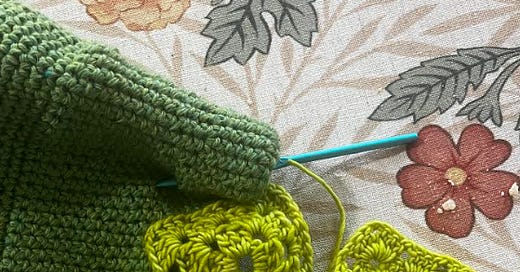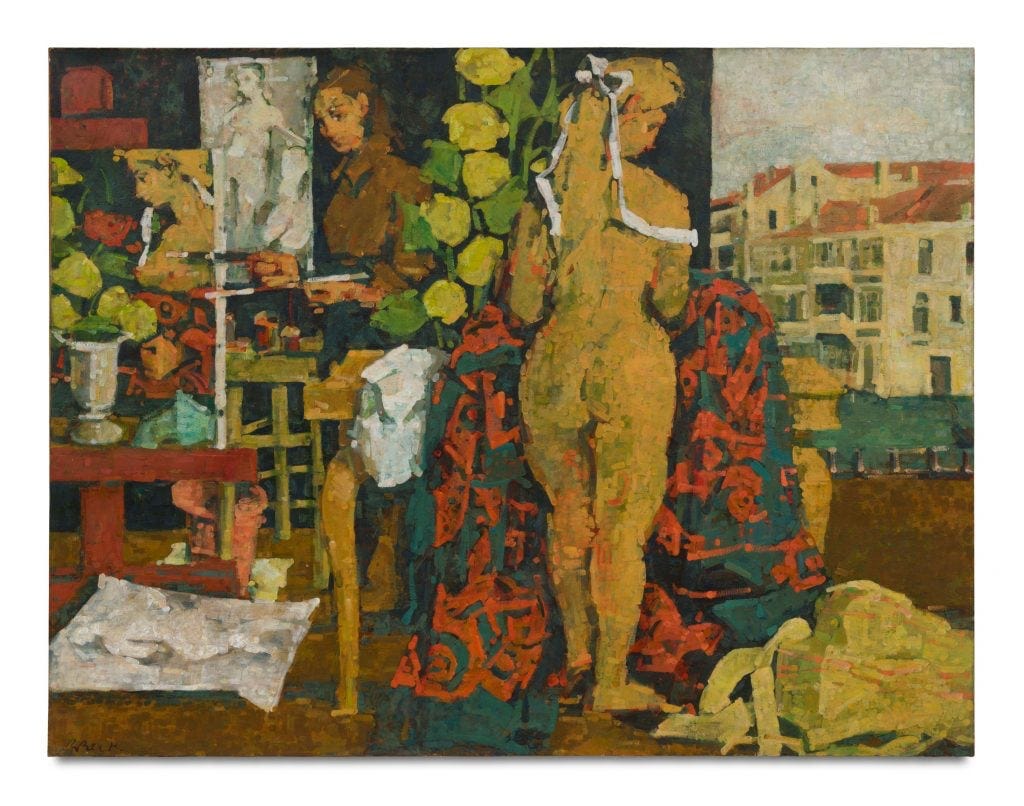In a little more than a week we will be celebrating Christmas. In less than a week, there will be the shortest day of the year; winter solstice. For some, this is a season to go to church and to reenact the birth of a Messiah. For others like myself it’s more of a time to slow down and be with family. It’s a time where we can allow ourselves some indulgences. Possibly putting aside those projects that didn’t seem to get done this year. It is also during these days when darkness seems to arrive too soon and the temperatures drop that I do a little bit of nesting.
As fate would have it I was forced by a pretty severe cold/flu to take a break at the beginning of December. Instead of working in my studio as I had planned, I ended up being in bed, coughing, blowing my nose,and teaching myself how to make crocheted granny squares. I finished a book, watched Yellowstone, and stumbled upon an article about an artist who could have been a big name, but instead decided to follow her own path.
The article titled: The Untold Story of Rosemarie Beck, the Abstract Artist Who Gave Up Fame For Figuration was published on artnet.com. It described how two decades after her death with the help of a granddaughter, who manages her foundation; a collection of work by Mrs. Beck is now on display at a New York Gallery. ("Earthly Paradise" at Van Doren Waxter Gallery) Her work almost disappeared from the art scene despite early success.
I read the article several times. What captivated me was the story of someone who began an extremely promising career and instead of being caught in the riptide pull of the New York art industrial complex of collectors and galleries; she answered to her internal voice, which wanted to go in another direction.
Beck was born in 1923. She graduated from Oberlin college with a degree in Art History. Post graduation she studied at Columbia and the Art Students League. She and her husband, publisher and writer Robert Phelps; settled down in Woodstock, New York outside the city. The creative community included artists like Philip Guston. Woodstock would be her home and studio for most of her life.
Beck was a woman who arrived on the art scene at the right time as a protege of Robert Motherwell. The 1950’s was the heyday for abstract expressionism and Beck was in the middle of a second wave of abstract expressionism. During that period her work was collected by the Whitney museum and exhibited at the Stable Gallery by its famous dealer Elenor Ward who represented artists like Robert Rauschenberg. By all measures Beck was successful.
In 1958 she left abstraction behind and began to work with the figure.
“The ore in my abstract veins had thinned. I thought I would nourish my abstract painting by painting subjects. Then I couldn’t go back. I must have been a secret realist all along because I had never stopped drawing from life,”
It was this turn that left her as a side note in the history of Art.
From 1958 until her death in 2004, she painted what the article described as “mythical and rebellious women”. Her strategy to regain momentum was to work on something that was not abstract was based on an assumption she would eventually she could go back to abstraction. Instead, the opposite happened, she found herself for 40 years passionately pursuing a subject matter rooted in story and featuring the female form .
After following a link on social media,I sat with a cup of chicken soup and dived into more information about a woman who found her authentic artistic voice as a woman and had the chutzpah to pursue her own path. It was then I found more of the work she kept to herself: embroidery. The “craft” was a secret passion she indulged throughout her life. A few of these are displayed in the current exhibition. I found these pieces much more intriguing than the larger scale formal oil paintings.
Many more artists in gallery settings are embracing materials associated with crafts. At Basel there has been an explosion of textile and fiberart work selling at higher prices to collectors. These artists use needle and thread instead of the materials deemed suitable for fine art. More importantly many are women are reclaiming territory once relegated to the status of mere domestic crafts, into the world of fine art.
In a recent article on the Art Basel Website the boom of textile art is clear.
According to art historian and textile artist Ferren Gipson, there has been a noticeable shift in the conversation surrounding textile-based art in recent years. At Art Basel Hong Kong in 2024, galleries are echoing Gipson's call by illuminating the growing importance of textiles and weaving practices in contemporary art by presenting artists from across generations and geographies, who utilize techniques such as felting, knotting, weaving, and dyeing to create unique and diverse artworks..
The increased status of textile art gives me a feeling of hope for the work that I do combining photographs, painting, and a sewing machine. When I first began presenting the work I found most people in the community of artists I was familiar with were put off by the odd mix of techniques. So I found myself embracing and isolating in a community of art quilters.
In the last couple of years I have ventured out once again to the art world and discovered acceptance; even enthusiasm for embracing textiles and techniques outside of the norms.
HAPPY HOLIDAYS HOWEVER YOU CELEBRATE
Until Next Time….







